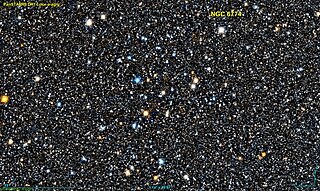83 Leonis, abbreviated 83 Leo, is a binary star system approximately 59 light-years away in the constellation of Leo. The primary star of the system is a cool orange subgiant star, while the secondary star is an orange dwarf star. The two stars are separated by at least 515 astronomical units from each other. Both stars are presumed to be cooler than the Sun.

Ruprecht 147 or NGC 6774 is a dispersed star cluster in the Milky Way galaxy. It is about 1,000 light years away, which is close to Earth in comparison with other such clusters. In late summer, it can be seen with binoculars in the constellation of Sagittarius. The stars, bound by gravity, are about 2.5 to 3.25 billion years old. The cluster, discovered in 1830 by John Herschel, was sometimes thought to be an asterism due to its sparseness and location against the background of the richest part of the Milky Way, and also since the brightest stars in this old cluster perished long ago. In 1966 the Czech astronomer Jaroslav Ruprecht classified it as a type III 2 m open cluster under the Trumpler scheme. It received otherwise little attention until 2012, when it was identified as a potentially important reference gauge for stellar and Galactic astrophysics research, particularly the research of Sun-like stars.
Kepler-80, also known as KOI-500, is a red dwarf star of the spectral type M0V. This stellar classification places Kepler-80 among the very common, cool, class M stars that are still within their main evolutionary stage, known as the main sequence. Kepler-80, like other red dwarf stars, is smaller than the Sun, and it has both radius, mass, temperatures, and luminosity lower than that of our own star. Kepler-80 is found approximately 1,223 light years from the Solar System, in the stellar constellation Cygnus, also known as the Swan.
Gliese 754 is a dim star in the southern constellation of Telescopium. It has an apparent visual magnitude of 12.25, which requires a telescope to view. The star is located at a distance of 19.3 light-years from the Sun based on parallax, and it is drifting further away with a radial velocity of +7 km/s. It is one of the hundred closest stars to the Solar System. Calculations of its orbit around the Milky Way showed that it is eccentric, and indicate that it might be a thick disk object.
HIP 41378 is a star located 346 light-years away in the constellation of Cancer. The star has an apparent magnitude of 8.92. This F-type main sequence dwarf has a mass of 1.15 M☉ and a radius of 1.25 R☉. It has a surface temperature of about 6,251 K.
K2-19 is an early K-type or late G-type main sequence star that is magnetically active, and has a light curve that exhibits variations in brightness of ~1%. It is located approximately 976 light-years away in the constellation Virgo. Three confirmed transiting exoplanets are known to orbit this star.
K2-58 is G-type main-sequence star in the constellation of Aquarius, approximately 596 light-years from Solar System. The star is metal-rich, having 155% of Solar abundance of elements heavier than helium. The star is located in the region allowing to see Venus transiting the Sun for hypothetical observer located in K2-58 system.

K2-18, also known as EPIC 201912552, is a red dwarf star with two planetary companions located 124 light-years from Earth, in the constellation of Leo.
K2-32 is a G9-type main sequence star slightly smaller and less massive than the sun. Four confirmed transiting exoplanets are known to orbit this star. A study of atmospheric escape from the planet K2-32b caused by high-energy stellar irradiation indicates that the star has always been a very slow rotator.
K2-24 is a metal-rich G3-type main sequence star larger and more massive than the Sun, located 560 light-years away in the constellation Scorpius. Two confirmed transiting exoplanets are known to orbit this star. An attempt to detect stellar companions using adaptive optics imaging at the Keck telescope was negative however later observations using lucky imaging at the Danish 1.54 m telescope at La Silla Observatory detected a possible companion at 3.8 arcseconds distance from K2-24. This candidate companion being over 8 magnitudes fainter than K2-24 and with a color temperature of 5400 Kelvin, is inconsistent with a bound main sequence companion.
HAT-P-28 is the primary of a binary star system about 1320 light-years away. It is a G-type main-sequence star. The star's age is older than the Sun's at 6.1+2.6
−1.9 billion years. HAT-P-28 is slightly enriched in heavy elements, having a 130% concentration of iron compared to the Sun. Since 2014, the binary star system is suspected to be surrounded by a debris disk with a 6.1″(2500 AU) radius.
HD 203473 is a star in the equatorial constellation Equuleus. With an apparent magnitude of 8.23, it’s only visible by using an amateur telescope. The star is located at a distance of 237 light years based on its parallax shift but is drifting closer at a high rate of 61.7 km/s. As of 2014, no stellar companions have been detected around the star.

K2-25 is a young red dwarf star located in the Hyades cluster. There is a single known Neptune-sized planet in a 3.5 day orbit.




